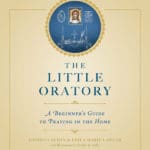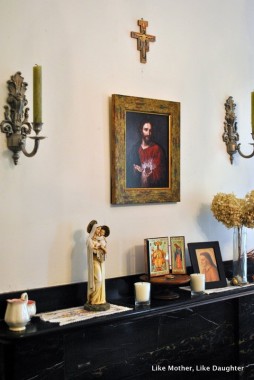Dear Dan, I have heard you speak and mention the importance of having a home altar or dedicated space to pray. I must admit that this is a completely foreign idea to me but it is also intriguing and I believe can help me in my prayer life and maybe my family too. Can you give me some detail about how one would go about setting up a home altar?
Dear Friend, absolutely! However, instead of answering this myself I would like to introduce someone who is better qualified than me to do so, my friend Leila Lawler who has written a fantastic book entitled “The Little Oratory” that covers this topic well. She will outline the basics and then if you are enticed, you should pick up her book.
************
Dear Friend – I know what you mean about this idea being completely foreign.To me, a convert, the notion was not attractive. I had absorbed the (completely true) teaching that I, a lay person, have a vocation to sanctify the world. It seemed to me that therefore I should avoid anything “churchy” in my home or appearance. So the idea of a place in the home that seemed “altar-ish” was not something that appealed to me. At the same time, raising my children, I knew that we needed visual and otherwise material ways to express our faith and for our home to become what St. Augustine (echoed by Saint Pope John Paul II in Familiaris Consortio) calls “the domestic church.”
Our faith is incarnational. That is, in the person of Jesus Christ, our faith unites heaven and earth, body and soul, spirit and matter. Sacred images, candles, colors, scents, sounds — these all deeply matter to Christians, especially in the home, where the children are being formed. The home is the place of the family, God’s original plan for the sanctification of his people. Our Lord Jesus Christ was born into a family! The home is an indispensable sanctuary.
I had known about, and was trying hard to implement, a life in the home that stays close to the Liturgical Year of the Church — one that celebrates the liturgical seasons (Advent, Christmas, Lent, Easter, Pentecost) as well as the saints’ feasts. When the family lives this way, they remain close to the Eucharist, which is offered to us in just this context of rhythm, of season. For one thing, nothing offers so great an opportunity to begin again, to renew our commitment to a life in the Lord, as this gift of the Liturgical Year. However, I found it difficult, without a place in the home, to do so, you might say, efficiently. I also yearned for something more completely traditional in a broad sense, rather than just conventional, but I didn’t know what that meant, exactly.
It wasn’t until I encountered the lovely little prayer corner of a friend that I understood how to go about  doing this. Nothing grand — simply a little spot where a few sacred images, a crucifix, a hand-embroidered cloth, a vial of holy water, and a candle could be set up to provide the focal point for the family’s devotions. It’s entirely up to each family to figure out what form this will take. Some prefer icons, some have a treasured crucifix and statue of Our Lady. My friend has vintage images of the Immaculate Heart of Mary and the Sacred Heart that center her corner. You almost certainly have what you need right now somewhere in your house, waiting to be gathered into one spot. If not, our book The Little Oratory: A Beginner’s Guide to Praying in the Home has 8 full-color icons that can be removed, framed, and hung in your prayer corner!
doing this. Nothing grand — simply a little spot where a few sacred images, a crucifix, a hand-embroidered cloth, a vial of holy water, and a candle could be set up to provide the focal point for the family’s devotions. It’s entirely up to each family to figure out what form this will take. Some prefer icons, some have a treasured crucifix and statue of Our Lady. My friend has vintage images of the Immaculate Heart of Mary and the Sacred Heart that center her corner. You almost certainly have what you need right now somewhere in your house, waiting to be gathered into one spot. If not, our book The Little Oratory: A Beginner’s Guide to Praying in the Home has 8 full-color icons that can be removed, framed, and hung in your prayer corner!
My friend told me how her children learned (by watching her and her husband, of course) to pause there, in the dining room, for a moment during the day to make a silent prayer. She may place an image of the saint of the day there. There she puts the cards she receives at funeral Masses to remember the dead. They still sit in the living room to say the Rosary (and there is a  statue and candle on the mantel there), but somehow their prayer corner expresses the sacred character of their home.
statue and candle on the mantel there), but somehow their prayer corner expresses the sacred character of their home.
Now, even though some of my children were fairly grown up at that point, I decided to go ahead and make my own prayer corner. My children know very well that we (my husband and I) are on a journey to learn more about our faith, so they weren’t surprised at seeing our mantel take shape (and even observed experiments around the house with placements that didn’t quite work).
Use the change of liturgical season to implement something you think will be helpful to family life, such as learning a new prayer, praying an Office of the Liturgy of the Hours, or setting up your prayer table. The Catechism calls this place in the home where the family can gather to pray: the “little oratory” [CCC 2691]. In our book, David Clayton and I embraced this term. We think it’s helpful to give the reader the freedom to make what suits his own family, whether it’s an icon corner, home altar, or prayer table. But we do encourage every family to explore the benefits offered by making a little oratory of some kind. Through this simple, traditional, yet to many perhaps new means, we find a real help in nourishing our family’s faith.
+
Art for this post on how to set up a home altar: Photography, book cover for The Little Oratory, and feature image of Leila Lawler: courtesy Leila Lawler, used with permission.





